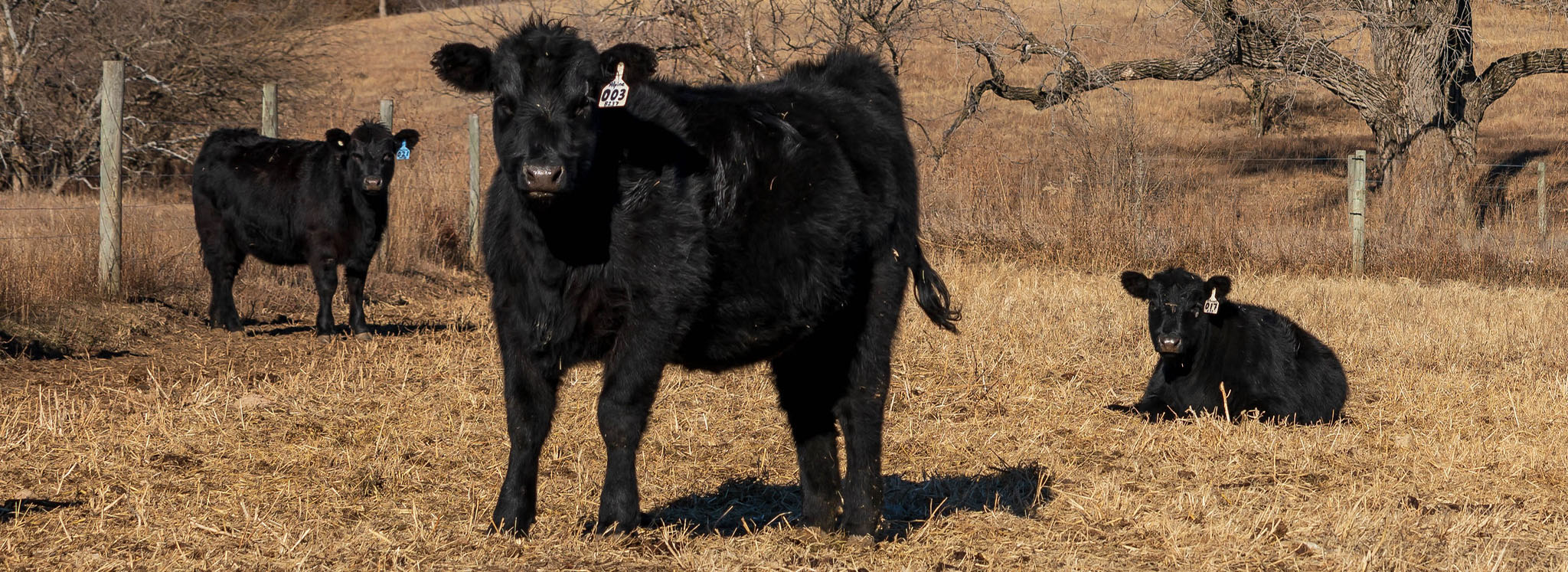
Management interventions can help heifers reach puberty. | Download photo
Cattle Chat: Helping heifers ahead of breeding
K-State veterinarians offer tips on how to help heifers start their heat cycles
At a glance: Management interventions can help heifers reach puberty, said the experts at Kansas State University’s Beef Cattle Institute.
More information: Phillip Lancaster, 532-6323, palancaster@vet.k-state.edu; Bob Larson, 785-532-4257, rlarson@vet.k-state.edu; Brian Lubbers, 785-532-4012, blubbers@vet.k-state.edu
Related: Beef Cattle Institute Cattle Chat
March 19, 2024
By Lisa Moser, K-State Research and Extension news service
MANHATTAN, Kan. – While it seems like a natural event, getting pregnant is not always as easy as it sounds, especially if the female isn’t having estrus cycles.
Specific to cattle, the experts at the Kansas State University Beef Cattle Institute offered tips on how to get heifers cycling on a recent Cattle Chat podcast.
The veterinarians recommend doing a pre-breeding exam on the heifers as early as six to eight weeks ahead of the start of the breeding season to assess the reproductive tract and overall health of the young females. Heifers typically start their estrus cycles around 12-13 months of age.
For heifers that are behind in their body weight and reproductive maturity, the BCI experts suggested a few options to help them along.
“For heifers that are too thin, I’d recommend adding grain to get them to gain between one and a half to two pounds a day,” said beef cattle nutritionist Phillip Lancaster. At that pace, the cattle should be able to add an extra 100 pounds or so in 45 to 60 days, he said.
Along with adding grain, Lancaster also recommends adding ionophores to the feed.
“An ionophore is a feed supplement that changes the fermentation in the rumen that provides additional blood glucose and will help the heifer begin cycling a little earlier than she might otherwise,” Lancaster said.
Along with adjusting the nutrition plan, K-State veterinarian Brian Lubbers said it is important to make sure the heifers have been treated with a deworming product.
“Having heifers on a good deworming program means they are losing less energy to parasites, and they can gain more weight because they are using their calories more efficiently,” Lubbers said.
Another tip is to expose the heifers to an older bull through fence line contact or use a vasectomized bull in the pasture with them.
“Although only a minor effect, research has shown that bull exposure will hasten the onset of puberty in females that are close to cycling,” said K-State veterinarian Bob Larson.
Larson also suggests using an estrus synchronization protocol that includes progesterone. He said this can be done through a feed additive such as MGA (melengestrol acetate) or with a CIDR (a product placed intravaginally for either seven or 14 days).
“MGA works well as long as they get their half milligram every day and it is fed for 14 days, while the CIDR is more expensive but is more flaw proof because if it is in their body, then you know they are getting the progesterone.”
Because of the cost of estrous synchronization and artificial insemination, Larson recommends that heifers that are behind at an eight-week pre-breeding exam be re-evaluated closer to breeding before committing to an artificial insemination mating.
“I normally don’t do the breeding soundness exams twice, but in a herd or group that is behind, I will because it may not be worth the expense of putting in a CIDR and semen in heifer that has a low chance of responding,” Larson said.
To hear the full discussion, listen to Cattle Chat on your preferred streaming platform.
***

K‑State Research and Extension is a short name for the Kansas State University Agricultural Experiment Station and Cooperative Extension Service, a program designed to generate and distribute useful knowledge for the well‑being of Kansans. Supported by county, state, federal and private funds, the program has county extension offices, experiment fields, area extension offices and regional research centers statewide. Its headquarters is on the K‑State campus in Manhattan. For more information, visit www.ksre.ksu.edu. K-State Research and Extension is an equal opportunity provider and employer.